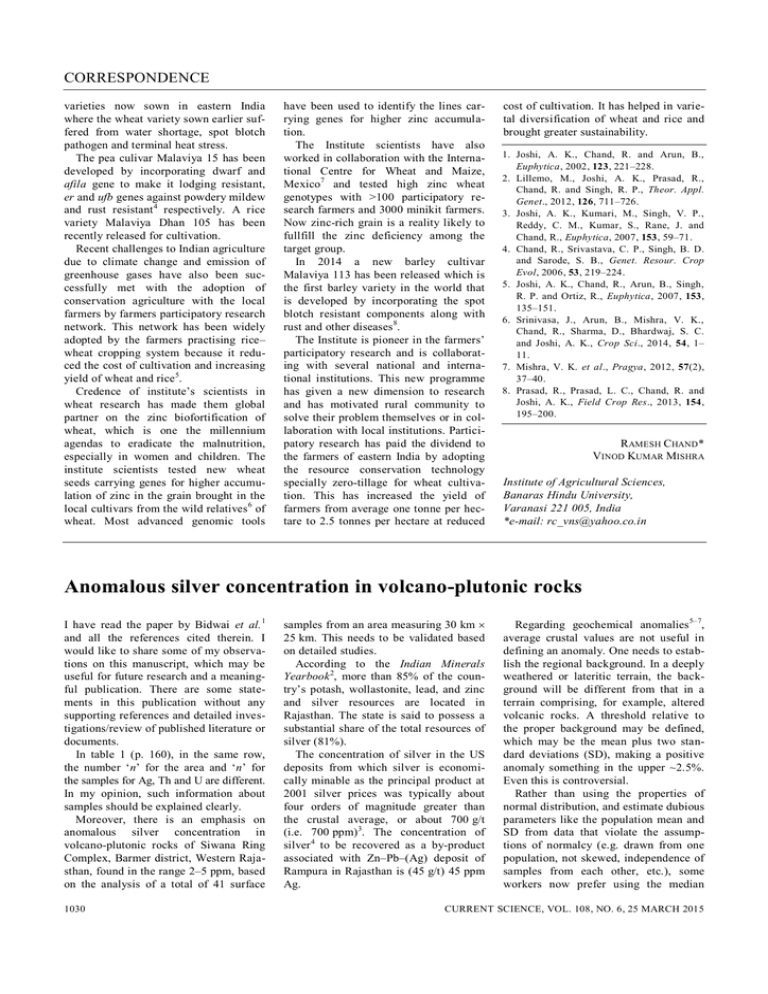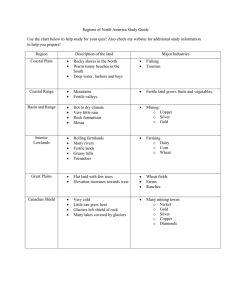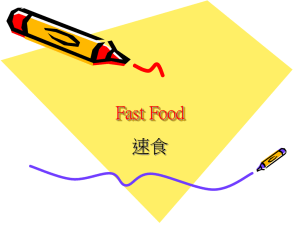Anomalous silver concentration in volcano
advertisement

CORRESPONDENCE varieties now sown in eastern India where the wheat variety sown earlier suffered from water shortage, spot blotch pathogen and terminal heat stress. The pea culivar Malaviya 15 has been developed by incorporating dwarf and afila gene to make it lodging resistant, er and ufb genes against powdery mildew and rust resistant 4 respectively. A rice variety Malaviya Dhan 105 has been recently released for cultivation. Recent challenges to Indian agriculture due to climate change and emission of greenhouse gases have also been successfully met with the adoption of conservation agriculture with the local farmers by farmers participatory research network. This network has been widely adopted by the farmers practising rice– wheat cropping system because it reduced the cost of cultivation and increasing yield of wheat and rice 5. Credence of institute’s scientists in wheat research has made them global partner on the zinc biofortification of wheat, which is one the millennium agendas to eradicate the malnutrition, especially in women and children. The institute scientists tested new wheat seeds carrying genes for higher accumulation of zinc in the grain brought in the local cultivars from the wild relatives 6 of wheat. Most advanced genomic tools have been used to identify the lines carrying genes for higher zinc accumulation. The Institute scientists have also worked in collaboration with the International Centre for Wheat and Maize, Mexico7 and tested high zinc wheat genotypes with >100 participatory research farmers and 3000 minikit farmers. Now zinc-rich grain is a reality likely to fullfill the zinc deficiency among the target group. In 2014 a new barley cultivar Malaviya 113 has been released which is the first barley variety in the world that is developed by incorporating the spot blotch resistant components along with rust and other diseases 8. The Institute is pioneer in the farmers’ participatory research and is collaborating with several national and international institutions. This new programme has given a new dimension to research and has motivated rural community to solve their problem themselves or in collaboration with local institutions. Participatory research has paid the dividend to the farmers of eastern India by adopting the resource conservation technology specially zero-tillage for wheat cultivation. This has increased the yield of farmers from average one tonne per hectare to 2.5 tonnes per hectare at reduced cost of cultivation. It has helped in varietal diversification of wheat and rice and brought greater sustainability. 1. Joshi, A. K., Chand, R. and Arun, B., Euphytica, 2002, 123, 221–228. 2. Lillemo, M., Joshi, A. K., Prasad, R., Chand, R. and Singh, R. P., Theor. Appl. Genet., 2012, 126, 711–726. 3. Joshi, A. K., Kumari, M., Singh, V. P., Reddy, C. M., Kumar, S., Rane, J. and Chand, R., Euphytica, 2007, 153, 59–71. 4. Chand, R., Srivastava, C. P., Singh, B. D. and Sarode, S. B., Genet. Resour. Crop Evol, 2006, 53, 219–224. 5. Joshi, A. K., Chand, R., Arun, B., Singh, R. P. and Ortiz, R., Euphytica, 2007, 153, 135–151. 6. Srinivasa, J., Arun, B., Mishra, V. K., Chand, R., Sharma, D., Bhardwaj, S. C. and Joshi, A. K., Crop Sci., 2014, 54, 1– 11. 7. Mishra, V. K. et al., Pragya, 2012, 57(2), 37–40. 8. Prasad, R., Prasad, L. C., Chand, R. and Joshi, A. K., Field Crop Res., 2013, 154, 195–200. RAMESH CHAND* VINOD KUMAR MISHRA Institute of Agricultural Sciences, Banaras Hindu University, Varanasi 221 005, India *e-mail: rc_vns@yahoo.co.in Anomalous silver concentration in volcano-plutonic rocks I have read the paper by Bidwai et al. 1 and all the references cited therein. I would like to share some of my observations on this manuscript, which may be useful for future research and a meaningful publication. There are some statements in this publication without any supporting references and detailed investigations/review of published literature or documents. In table 1 (p. 160), in the same row, the number ‘n’ for the area and ‘n’ for the samples for Ag, Th and U are different. In my opinion, such information about samples should be explained clearly. Moreover, there is an emphasis on anomalous silver concentration in volcano-plutonic rocks of Siwana Ring Complex, Barmer district, Western Rajasthan, found in the range 2–5 ppm, based on the analysis of a total of 41 surface 1030 samples from an area measuring 30 km 25 km. This needs to be validated based on detailed studies. According to the Indian Minerals Yearbook 2, more than 85% of the country’s potash, wollastonite, lead, and zinc and silver resources are located in Rajasthan. The state is said to possess a substantial share of the total resources of silver (81%). The concentration of silver in the US deposits from which silver is economically minable as the principal product at 2001 silver prices was typically about four orders of magnitude greater than the crustal average, or about 700 g/t (i.e. 700 ppm) 3. The concentration of silver 4 to be recovered as a by-product associated with Zn–Pb–(Ag) deposit of Rampura in Rajasthan is (45 g/t) 45 ppm Ag. Regarding geochemical anomalies 5–7, average crustal values are not useful in defining an anomaly. One needs to establish the regional background. In a deeply weathered or lateritic terrain, the background will be different from that in a terrain comprising, for example, altered volcanic rocks. A threshold relative to the proper background may be defined, which may be the mean plus two standard deviations (SD), making a positive anomaly something in the upper ~2.5%. Even this is controversial. Rather than using the properties of normal distribution, and estimate dubious parameters like the population mean and SD from data that violate the assumptions of normalcy (e.g. drawn from one population, not skewed, independence of samples from each other, etc.), some workers now prefer using the median CURRENT SCIENCE, VOL. 108, NO. 6, 25 MARCH 2015 CORRESPONDENCE rather than the mean, and the median of the absolute deviation of all analyses from the median (the median absolute deviation, or MAD), rather than the SD. A positive anomaly is then defined as the median + 2MAD. Keeping in view the above definitions, the anomalous concentration of silver in the range 2–5 ppm found in areas of Rajasthan needs to be further validated after careful detailed studies and discussions with the supporting updated references as on date. On p. 160, the authors claim that ‘The importance of SRC (Siwana Ring Complex) for its potential for uranium, thorium, rare metals and REE was realized by AMD in the late 1950s’. There is only one paper by AMD8 (ref. 5 in the manuscript 1, published in 1996) which summarizes the work carried out by AMD during the period 1976 to 1996. It was stated in this paper 8 that ‘Detailed chemicomineralogical investigations of these dyke samples are underway’. In addition, the following conclusions are drawn in this communication8 (p. 858): ‘In view of the anomalous abundances of these strategic elements in them, these dykes and the remaining western half of grainite ring needs further detailed investigations to evaluate their trace element potential and economic feasibility for possible exploitation in future.’ The authors’ should have summarized the detailed findings supported by the references. At the same time, the authors’ stated that1 ‘The volcano-plutonic complex has been extensively studied for its stratigraphy, geology, structure, petromineralogy, geochemistry and geochronological aspects’ 1–4. From table 1 of the paper 1, U/Th radiometric data, except at Mawri area, are rich in thorium. Therefore, leachability/ recovery of uranium from such a matrix needs to be investigated. It is clear that since 1950, AMD has not carried out any systematic detailed survey of this area. There is no new information compared to the earlier publication by AMD8 in 1996. The authors are advised to summarize the results of detailed chemicomineralogical investigations of these volcanogenic multimetal radioactive mineralized dykes carried out by AMD since 1950, together with the economic feasibility for their possible exploitation in future. 1. Bidwai, R., Srinivasan, S., Nanda, L. K., Banerjee, A., Bangroo, P. N., Rai, A. K. and Parihar, P. S., Curr. Sci., 2014, 106, 159–162; Erratum, Curr. Sci., 2014, 106, 367. 2. Indian Minerals Yearbook 2012 (Part-I) 51st Edition (Advance Release), State Reviews (Rajasthan), Ministry of Mines, Government of India, Indian Bureau of Mines, Nagpur, 2013; www.ibm.gov.in 3. Butterman, W. C. and Hilliard, H. E., Open-file report 2004-1251, US Geological Survey, Reston, Virginia, 2005; http:// www.usgs.gov/pubprod 4. Deb, M., Kaur, G. and Sarkar, S. C., Metallogeny, 2008; Earth Processes and Resources.pdf; http://nsdl.niscair.res.in and reference cited therein. 5. http://www.frontiermining.kz/sections/Glossary 6. US Geological Survey Bulletin, p. B-12, Google Books Result, 1983; books. google.co.in/books?id=FCXwAAAAMAAJ 7. http://www.geol.umd.edu/facilities/lmdr/ EconGeolTerms.pdf 8. Jain, R. B., Miglani, T. S., Kumar, S., Swarnakar, B. M. and Singh, R., Curr. Sci., 1996, 70(9), 854–858. D. P. S. RATHORE STRC, WR, Atomic Minerals Directorate for Exploration and Research, Department of Atomic Energy, Jaipur 302 033, India e-mail: dpsr2002@yahoo.com; dpsrathore.amd@gov.in Response: Rathore refers to the discrepancy in the number of samples in the area vis-à-vis samples analysed for Ag. We wish to mention that, the theme of the paper was to present the distribution of Ag in the various lithounits in the Siwana Ring Complex (SRC) and the rocks prevailing along the margin, representing unique geological setting and geological environment. In concurrence to the theme of the paper, population of the samples analysed for Ag outnumbered those analysed for other elements. Hence, the difference lies in the number of samples analysed as indicated by Rathore. Rathore wants to make a point regarding the economics of the silver deposits CURRENT SCIENCE, VOL. 108, NO. 6, 25 MARCH 2015 and silver as a by-product from Zn–Pb– (Ag) deposits of Rajasthan. The data presented in support are indeed valid. However, he seems to have missed the objective of our paper, which was to report the initial data representing the anomalous concentration of Ag. There is no mention of economic viability of Ag in the analysed rock samples. Further, data on Ag in various rock units of SRC have not been reported earlier in the published literature. As regards the much ado about the word ‘anomalous’, it may be well appreciated that we have compared natural concentration of Ag in various/different lithologies and those prevailing in SRC, which clearly reveals that concentration of Ag in different lithologies at places exceeds more than 100 times that of the natural background/average abundance of Turekian and Wedepohl (1961). Such values of Ag judged by any parameter, would always fall under the ‘anomalous’ category (tables 2 and 3 in our paper). Further mincing words such as anomaly and threshold (X + 2 or MAD) is beyond the scope of the paper. We are aware of earlier investigations of AMD mostly targeting uranium, rare metals and REE, mainly confined to the southern margins of SRC and Siwana Fort Hill in the central Caldera, the details of which are well documented in the 1996 publication of AMD. Rathore has also commented about leachability/recovery of uranium and U/Th ratio. It may be noted that this was not the prime objective of our paper and hence was not presented as key points for arriving at any conclusion. In fact, we just wanted to bring it to the notice of the readers that uranium values are also associated with the samples analysed considering the probability of locating multi-elemental deposits, which is the need of the hour. Such topics may form the subject of an ensuing publication on the study area, once sizeable data to that effect are accrued and interpreted. RAJEEV BIDWAI Atomic Minerals Directorate for Exploration and Research, Western Region, Jaipur 302 030, India e-mail: rbidwai.amd@gov.in 1031


